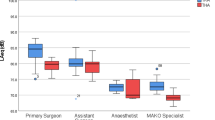Abstract
The conductor of an orchestra is able to distinguish not only between different instruments, but even among dozens of string players performing on instruments with similar sound qualities. Trained human ear not only is capable to highly differentiate between pitches and colors of sound, but also to localize the position, where the sound is coming from. This paper presents a parameter mapping sonification approach on production data, which is based on these human perceptual skills. Representatively for other logistic parameters, throughput times of orders are sonified and allocated in a sonic space. Additionally to auditory representations of the established resource and order oriented views in logistics, a third perspective is introduced, which displays the complete workflow of an order simultaneously as a multi-pitched spatial sound. Thus, causes and impacts of high throughput times in the data set example could be identified.













Similar content being viewed by others
Notes
Playback speed of sonification can be set arbitrarily in the software.
For confidential reasons, time-related information refers to neutral time unit.
Fluctuations of work system 1 and 2 at least partly depended on incomplete data and therefore were not further considered.
So to speak “acoustic fingerprints” of orders.
The operation times (TOP) at the work systems were of comparable length and, given the overall duration of TTPs, negligible.
References
Windt K, Philipp T, Böse F (2008) Complexity cube for the characterization of complex production systems. Int J Comput Integr Manuf 21(2):195–200
Nyhuis P, Wiendahl H-P (2009) Fundamentals of production logistics. Springer, Berlin
Choudhary AK, Harding JA, Tiwari MK (2008) Data mining in manufacturing: a review based on the kind of knowledge. J Intell Manuf 20(5):501–521
Tukey JW (1977) Exploratory data analysis. Addison-Wesley, Reading, MA
Wainer H (2005) Graphic discovery: a trout in the milk and other visual adventures. Princeton University Press, Princeton
Iber M, Klein J, Windt K (2012) Die Grooving Factory, Logistische Datenanalyse im Klanglabor. In: Schoon A, Volmar A (eds) Das geschulte Ohr: Eine Kulturgeschichte der Sonifikation, 1st edn. Transcript, Bielefeld, pp 147–163
Gutenberg E (1983) Grundlagen der Betriebswirschaftslehre, Erster Band: Die Produktion, 24th edn. Springer, Berlin
Yu K-W (2001) Terminkennlinie, Eine Beschreibungsmethodik für die Terminabweichung im Produktionsbereich. VDI, Düsseldorf
Mizuyama H (2006) Artificial-neural-network-based MSQIM for exploratory analysis of manufacturing data. In: Proceedings of the 7 th Asia Pacific industrial engineering and management systems conference, 17–20 Dec 2006, Bangkok, Thailand, no. December, pp 10–19
Windt K, Hütt M-T (2011) Exploring due date reliability in production systems using data mining methods adapted from gene expression analysis. CIRP Ann Manuf Technol 60(1):473–476
Liao TW, Ting C-F, Chang P-C (2006) An adaptive genetic clustering method for exploratory mining of feature vector and time series data. Int J Prod Res 44(14):2731–2748
Kramer G (1997) Sonification report: status of the field and research agenda. (Online). Available: http://www.icad.org. Accessed 19 Mar 2012
Pereverzev SV, Loshak A, Backhaus S, Davis JC (1997) Quantum oscillations between two weakly coupled reservoirs of superfluid 3 He. Nature 388:449–452
Frysinger SP (2005) A brief history of auditory data representation to the 1980s. In: First symposium on auditory graphs
de Campo A, Dayé C, Frauenberger C, Vogt K, Wallscih A, Eckel G (2006) Sonification as an interdisciplinary working process. In: Proceedings of the 12th international conference on auditory display, pp 28–35
Hermann T (2002) Sonification for exploratory data analysis. (Online). Available: http://pub.uni-bielefeld.de/pub?func=drec&id=2017263. Accessed 24 Feb 2012
Wiendahl H-P (2008) Betriebsorganisation für Ingenieure. Carl Hanser Verlag, München und Wien
Gläsner J, Fastabend H Lecture presentation material of Institut für Fabrikanlagen (IFA), Leibniz University Hannover
Acknowledgments
The research of Prof. Dr.-Ing. Katja Windt is supported by the Alfried Krupp Prize for Young University Teachers of the Krupp Foundation. This project was initiated and supported by the research group “Rhythm” of The Young Academy at the Berlin-Brandenburg Academy of Sciences and Humanities and the German Academy of Natural Scientists Leopoldina: www.diejungeakademie.de.
Author information
Authors and Affiliations
Corresponding author
Rights and permissions
About this article
Cite this article
Iber, M., Windt, K. Order-related acoustic characterization of production data. Logist. Res. 5, 89–98 (2012). https://doi.org/10.1007/s12159-012-0084-y
Received:
Accepted:
Published:
Issue Date:
DOI: https://doi.org/10.1007/s12159-012-0084-y



